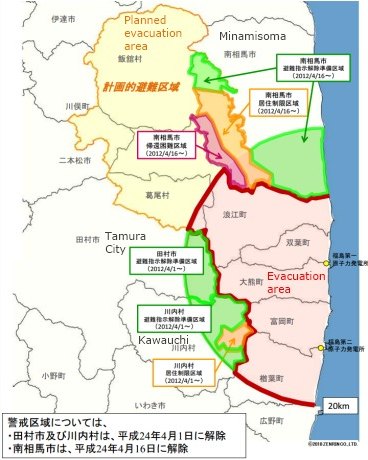Restrictions in sizeable parts of Fukushima's evacuation area have been relaxed, enabling some residents to visit at will and work towards a permanent return. Two towns have opened, and a third will follow in two weeks' time.
At midnight on 1 April the restrictions on several areas within 20 kilometres of the Fukushima Daiichi nuclear power plant were revised. A significant part of these had shown dose rates caused by ambient radioactivity to be below 20 millisieverts per year - the government's benchmark for the return.
Evacuated residents of Kawauchi village and Tamura City previously needed a police permit to visit the homes they were forced to abandon last year during the Fukushima nuclear accident. Now, they may return to homes and businesses without the use of protective equipment. This means that major repairs can be made to homes damaged by the earthquake of 11 March 2011, and businesses that do not draw custom from local people may now go back to work. Farming is allowed again in line with general restrictions on the wider area. In parallel, authorities will be working to restore infrastructure needed for normal life to resume. The only restriction is that people are not yet allowed to stay overnight.
The Japanese government has identified three classes of area: One is that described above, with ambient radiation levels below 20 millisieverts per year in which residents can now move freely but not stay overnight; Another has dose rates between 20 and 50 millisieverts per year which are marked as 'restricted', where residents can briefly enter to conduct specific jobs without being monitored or using protective equipment.
 |
| Green: An area to which people may return but not stay overnight Orange: A 'restricted' area; dose rate of over 20 millisieverts per year Purple: A 'difficult' area; dose rate of 20-50 millisieverts per year Parts of Kawauchi and Tamura are in the eastern portion of the evacuation zone, while Minamisoma is in the north and will see its restrictions relaxed later this month |
People entering the 'restricted' areas were advised to avoid doing so unnecessarily, to refrain from working outdoors, to use cars rather than to walk for more than a short period and to wash upon re-entering a building. Residents were told not to drink water from rivers, but that water from the tap would present no problem.
The third category of area is known as 'difficult' to return to because of an ambient dose rate of over 50 millisieverts per year, which is not expected to go below 20 millisieverts per year before March 2016 - five years after the accident. Entering these areas is possible for purposes in the public interest, although people doing so should use monitors and protective gear.
Japan's Ministry of Economy Trade and Industry (METI) said that local governments have been strongly demanding early returns to begin the restoration of the infrastructure that will support the return to normality.
Parts of a third city, Minamisoma, will be granted the same status changes on 16 April with much of this change relating to the 'planned evacuation area' to the north east of Fukushima Daiichi.
The Japanese central government aims to decontaminate all areas so that the additional radiation dose for residents from the accident will not exceed 20 millisievert per year. For areas frequented by children the aim is for this to be less than 1 millisievert per year.
Researched and written
by World Nuclear News





_47120.jpg)

_23621.jpg)






